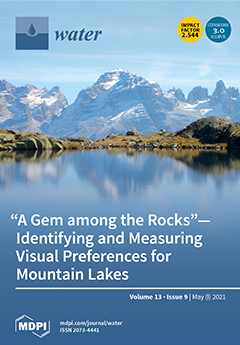The present work reports the assessment of the effectiveness of a foliar-spray of salicylic acid (SA) on growth attributes, biochemical characteristics, antioxidant activities and osmolytes accumulation in wheat grown under control (100% field capacity) and water stressed (60% field capacity) conditions. The total
[...] Read more.
The present work reports the assessment of the effectiveness of a foliar-spray of salicylic acid (SA) on growth attributes, biochemical characteristics, antioxidant activities and osmolytes accumulation in wheat grown under control (100% field capacity) and water stressed (60% field capacity) conditions. The total available water (TAW), calculated for a rooting depth of 1.65 m was 8.45 inches and readily available water (RAW), considering a depletion factor of 0.55, was 4.65 inches. The water contents corresponding to 100 and 60% field capacity were 5.70 and 1.66 inches, respectively. For this purpose, seeds of two wheat cultivars (Fsd-2008 and S-24) were grown in pots subjected to water stress. Water stress at 60% field capacity markedly reduced the growth attributes, photosynthetic pigments, total soluble proteins (TSP) and total phenolic contents (TPC) compared with control. However, cv. Fsd-2008 was recorded as strongly drought-tolerant and performed better compared to cv. S-24, which was moderately drought tolerant. However, water stress enhanced the contents of malondialdehyde (MDA), hydrogen peroxide (H
2O
2) and membrane electrolyte leakage (EL) and modulated the activities of antioxidant enzymes (superoxide dismutase (SOD), peroxidase (POD), and catalase (CAT), as well as accumulation of ascorbic acid (AsA), proline (Pro) and glycine betaine (GB) contents. Foliar-spray with salicylic acid (SA; 0, 3 mM and 6 mM) effectively mitigated the adverse effects of water stress on both cultivars. SA application at 6 mM enhanced the shoot and root length, as well as their fresh and dry weights, and improved photosynthetic pigments. SA foliage application further enhanced the activities of antioxidant enzymes (SOD, POD, and CAT) and nonenzymatic antioxidants such as ascorbic acid and phenolics contents. However, foliar-spray of SA reduced MDA, H
2O
2 and membrane permeability in both cultivars under stress conditions. The results of the present study suggest that foliar-spray of salicylic acid was effective in increasing the tolerance of wheat plants under drought stress in terms of growth attributes, antioxidant defense mechanisms, accumulation of osmolytes, and by reducing membrane lipid peroxidation.
Full article





